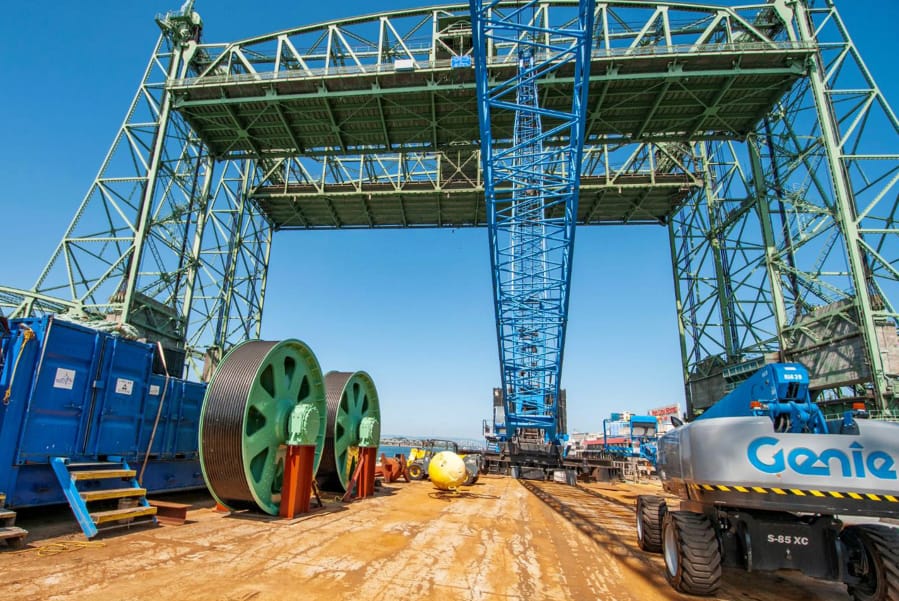The big Interstate 5 Bridge trunnion replacement project is less than a month away, and motorists will soon see more preparation and testing work as C-Tran and two state transportation departments count down to the Sept. 12 start date.
The project will close the northbound span of the bridge for nine days, from Sept. 12 to 20, while contractors replace a cracked trunnion at the top of the bridge’s south tower. Northbound and southbound I-5 traffic will share the three-lane southbound span during the project, with the central lane functioning as a reversible rush-hour lane.
Contractors for ODOT began preliminary work on the bridge this week, a few days after a barge arrived at the bridge carrying the replacement components and a crane that will be used for the project.
Meanwhile, WSDOT and C-Tran are finishing up two other I-5 corridor projects — a bus-on-shoulder lane and a new traffic management system — both of which are intended to try to help mitigate traffic congestion arising from the closed northbound span.
The initial task for the bridge construction team is to rebuild the I-5 median directly north and south of the bridge to allow northbound traffic to cross over to the southbound side during the closure. That work requires overnight closures of one or two lanes at a time in both directions.
Crews will also begin to build falsework under the northbound bridge — temporary structures to hold it up while the lift system is repaired. The project will replace the twin sheave wheels at the top of the tower — the central components of the lift system — as well as the trunnion, which is like an axle for the wheels.
Drivers can expect to see additional individual lane closures in the coming weeks, as well as bridge lifts on the northbound span related to the project. Some of the lifts might be longer than usual, potentially up to 30 minutes, although according to ODOT spokesman Don Hamilton, the crews will still need to follow an existing rule that prohibits bridge lifts during rush hour — 6:30 to 9 a.m. and 2:30 to 6 p.m.
Other projects
WSDOT and C-Tran are working to build and operate a bus-on-shoulder lane on a 5-mile stretch of I-5 southbound leading up to the bridge. The project involved slightly narrowing the main travel lanes of I-5 in order to widen the shoulder to 14 feet.
Construction began earlier this summer and wrapped up last week, according to C-Tran spokeswoman Chris Selk. The agency is drawing up a training schedule, and drivers should expect to start seeing C-Tran buses doing training operations soon.
The lane will continue to function as a regular shoulder most of the time, but bus operators will be allowed to move over to the shoulder to bypass the traffic jam during peak congestion when traffic drops below 35 mph. C-Tran began using a similar system on portions of state Highway 14 east of Interstate 205 in 2017.
WSDOT is also finishing an upgrade to the traffic management system on the I-5 corridor through Vancouver. The system includes new digital message boards and speed advisory signs for individual lanes, allowing WSDOT to provide real-time information to drivers.
It also includes ramp signal systems at several freeway interchanges.
Some of the system sites are still undergoing final modifications, according to WSDOT spokeswoman Tamara Greenwell, but others have moved on to testing. The system is targeted to roll out in early September, Greenwell said, although from the average driver’s perspective, there may not be a specific start date.
“The system is dynamic and only turns on just before traffic begins to stack up on the interstate, so even after our ‘go live’ date, travelers will not see the system activate until we see congestion,” she wrote in a message.
Both projects were timed to finish ahead of the trunnion project in the hopes that they would help ease traffic congestion during the nine-day closure. With the freeway’s traffic capacity reduced to one or two lanes in each direction, the traffic impacts are expected to be severe.
ODOT and WSDOT have spent months urging commuters to plan ahead and adjust their schedules to avoid crossing the bridge during peak hours (or better yet, not cross it at all) during the closure. Commuters reportedly took that message to heart in 1997 during a similar repair — traffic levels fell dramatically during that project. ODOT and WSDOT are hoping for a similar reaction this time around, but the population of Clark County has grown significantly in the two decades since then.
The pandemic may provide a slight advantage, both by getting commuters and employers used to the idea of working from home and decreasing the amount of traffic already on the freeway. Traffic levels on that part of I-5 are currently holding between 8 and 17 percent below normal, Greenwell said.
“That said, we’ll need a lot more people to change how they travel during the closure of the northbound span of the bridge for the trunnion replacement,” she added, “or we’ll see traffic backups for miles and extremely long delays — folks could be stuck in traffic for hours.”




